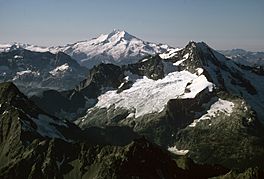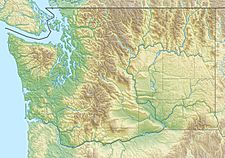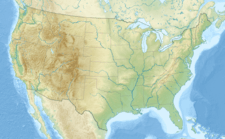Mary Green Glacier facts for kids
Quick facts for kids Mary Green Glacier |
|
|---|---|

Mary Green Glacier, front and center on Bonanza Peak which is right of center. Glacier Peak in the background.
|
|
| Type | Alpine glacier |
| Location | Chelan County, Washington, U.S. |
| Coordinates | 48°14′20″N 120°51′15″W / 48.23889°N 120.85417°W |
| Length | .50 mi (0.80 km) |
| Terminus | Barren rock |
| Status | Retreating |
The Mary Green Glacier is a cool natural ice formation found in the Wenatchee National Forest in the state of Washington, U.S. It sits high up on the eastern side of Bonanza Peak. This peak is special because it's the tallest mountain in the Cascade Range that isn't a volcano.
The Mary Green Glacier stretches from about 8,500 feet down to 7,200 feet above sea level. It was named after the wife of a prospector, someone who searched for valuable minerals. This glacier is also located along a very popular path that climbers use to reach the top of Bonanza Peak.
Contents
Discovering Mary Green Glacier
Mary Green Glacier is a fascinating part of the natural world. It's a large body of ice that moves very slowly. Glaciers like this one are important for many reasons, from shaping landscapes to providing water.
Where is Mary Green Glacier?
This glacier is located in the beautiful Cascade Range, a long chain of mountains in western North America. The Cascades stretch from southern British Columbia in Canada down through Washington and Oregon to northern California. Mary Green Glacier is specifically in Chelan County, Washington, within the Wenatchee National Forest. This forest is known for its amazing scenery, tall trees, and many outdoor activities.
The glacier rests on the side of Bonanza Peak. This mountain is a giant, standing tall among other peaks in the Cascades. It's not a volcano, which makes it different from some of the more famous mountains in the range like Mount Rainier or Mount St. Helens.
What is a Glacier?
A glacier is like a huge, slow-moving river of ice. It forms over many years when more snow falls in winter than melts in summer. This snow gets packed down by new layers of snow, turning into ice. Over time, the weight of the ice makes it flow slowly downhill, or spread outwards.
Mary Green Glacier is an "alpine glacier," which means it forms in mountain valleys. These glaciers carve out valleys and shape the landscape as they move. The glacier is currently "retreating," which means it's getting smaller. This happens when more ice melts than is replaced by new snow.
How Mary Green Glacier Got Its Name
Many natural landmarks are named after people or events. The Mary Green Glacier was named after the wife of a prospector. Prospectors were people who explored areas, often in the mountains, looking for valuable minerals like gold or silver. It's a way to remember the people who were part of the early exploration of this region.
Why Glaciers are Important
Glaciers like Mary Green are more than just big chunks of ice. They are vital parts of our planet's environment.
- Water Supply: Many communities rely on meltwater from glaciers for drinking water, farming, and producing electricity.
- Climate Clues: Glaciers are like giant thermometers. Scientists study them to understand how Earth's climate is changing over time. When glaciers retreat quickly, it can be a sign of a warming climate.
- Ecosystems: The cold meltwater from glaciers creates unique habitats for plants and animals.
Understanding and protecting glaciers helps us learn more about our world and how to take care of it.



